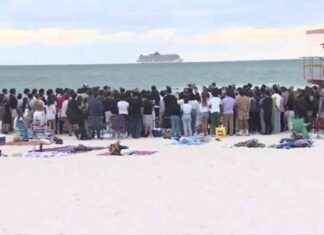Moscow responded yesterday to the manifest support for Ukraine reiterated by NATO leaders in Madrid with a double attack in Odessa province. At least 19 people, including two children, were killed and more than thirty wounded by three Russian X-22 missiles fired early Friday at a nine-story apartment building and a tourist complex in the Bilhorod-Dnistrovskyi district, in the south-west of the country, according to the Ukrainian presidency.
Most of the victims died in the attack on the residential building, located in the small town of Serhiivka, about 50 kilometers southwest of the city of Odessa. Part of the block was destroyed and the fire engulfed an adjoining commercial building. Firefighters were able to rescue at least seven people, while 38 others were injured, including a pregnant woman and six minors.
The Kremlin denied Kyiv’s accusations and insisted that it never targets civilian targets but rather military infrastructure in what it calls a “special operation.” Yet thousands of civilians have been killed since Russia invaded Ukraine on February 24.
With its ground forces concentrated in the industrial Donbass region of eastern Ukraine, Russia has more than doubled the number of missile strikes across the country in the past two weeks, targeting a residential neighborhood in Kyiv or the shopping center of Kremenchuk. To do this, Moscow uses imprecise Soviet-era missiles in more than half of the attacks, a Ukrainian brigadier general told Reuters.
The Odessa region has the only seaport in Ukraine that the Russians do not yet control and it borders Moldova and Romania. With the withdrawal of Russian forces from nearby Snake Island on Thursday, the threat to the port was expected to diminish.
Russia said it was leaving the strategic islet as a “goodwill gesture” to show Moscow was not obstructing UN efforts to open a humanitarian corridor to allow grain exports. Despite such demonstrations, the truth is that on Thursday the export of 7,000 tons of Ukrainian grain began in Berdyansk, in the occupied zone, on a Russian-flagged ship. Kyiv, on the other hand, considered that it had expelled the Russian forces after an assault with artillery and missiles, and President Volodymyr Zelensky hailed the victory.
Yesterday’s attack in Odessa occurred a day after the NATO summit was held in Madrid, in which more aid to Ukraine was announced and Russia was condemned as the main global adversary.
Meanwhile, in the Donbass, Moscow claimed to be at the gates of the city of Lisichansk, the only bastion left for the Ukrainian forces in the Luhansk province, which Moscow and the pro-Russian separatists aspire to control together with the Donetsk province.
Since taking the neighboring city of Severodonetsk, across the Siverskyi Donets River, Russia has come closer to achieving its goal. Russian military sources assured yesterday that his troops had taken control of a refinery and other industrial zones in the south and southeast. According to the representative in Russia of the self-proclaimed Luhansk People’s Republic, Rodion Miroshnik, Russian troops were besieging the city from four directions. In the south, where there is a rubber goods factory, his troops “not only entered the city, but carried out ‘clean-up operations’ in the surrounding blocks,” he added.
Luhansk Governor Serhiy Haidai did not yet write off the refinery but warned that Russian forces were “destroying one house after another with heavy artillery and other weapons.” “The inhabitants of Lisichansk take refuge in cellars almost all day,” he said. While the offensive has so far failed to cut Ukraine’s supply lines, the main road leading west has been rendered useless by constant shelling, so civilians cannot be evacuated, according to the governor.








